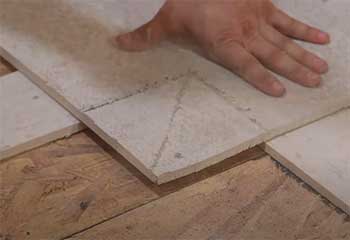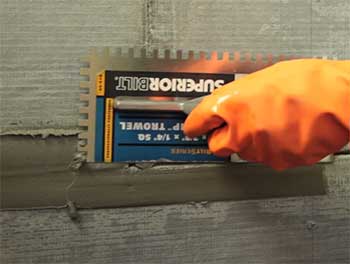When it comes to the debate between Wonderboard vs. Hardiebacker backer boards, it’s easy to become confused!
But hang in there!
We’re here to give you information on two of the most popular backer boards. The Backer board is a type of tile surface. Backerboard, unlike hardwood and other wooden surfaces, is rigid and flat, so it won’t break.
Cement board, also known as backer board, is a great addition to any DIY project more importantly to your bathroom.
A Quick Comparison Table
| Specifications | Wonderboard | Hardiebacker |
| Ingredients | Fiberglass mesh-reinforced cement is about 20% lighter than traditional cement. | Portland cement and sand, plus unique additives, make up about 90% of the mix. |
| Durability | Approximately Up-to 50 years | Approximately up to 40 years |
| Compatibility | Almost all the surfaces | Any surfaces |
| Uses | Mostly in water-resistant residential and less preferably in commercial environments | Both residential and commercial environment |
| Water Resistant Capability | Not Waterproof | Waterproof |
| Price | Medium | Fairly High |
Key Differences Between Wonderboard And Hardiebacker

- Ingredients
The most significant factor in this type of home element is the material, especially in bathroom features like backboards. There are a lot of things that are solely dependent on the materials used in the items.
The materials have an indirect and occasionally direct impact on durability, affordability, pricing, and service. If superior materials are used, the product will survive a long time; otherwise, it will not.
The WonderBoard firm produces the WonderBoard backer board. That is constructed of a fiberglass and cement mixture with mesh reinforcement.
It lacks fiber and gypsum, which reduces the backer boards durability.
One of the most distinguishing features of WonderBoard is its 20 percent lighter fiberglass, which makes it simpler to work with.
It has high strength due to its unique recipe, making it better suitable for curved surfaces than other cement board brands.
Portland cement, the most popular form of cement for regular use, and sand are the essential ingredients of HardieBacker cement board.
The added materials, on the other hand, are what set this kind of board unique from the rest. HardieBacker includes cellulose fibers as well as the MoldBlock ingredient.
It may be used as a tile backer board and underlayment for tile, vinyl, and wood floors.
It is made up of 90% Portland cement and sand, is moisture resistant, and has great tile adhesion.
- Durability

Cement boards are less prone to faults and damages since they are more resilient.
So we expect you don’t have to deal with any serious, pricey difficulties until after a few years if you install the board properly and follow simple maintenance.
Both the backboard have done an excellent job in terms of product durability and strength.
Wonderboard can last up to 50 years with good maintenance, however, this varies.
One of WonderBoard’s benefits over HardieBacker is its dependability. Because its substance is more akin to typical cement backer boards, it is somewhat stronger and more durable than HardieBoard.
Hardibecker can last for up to 40 years, however, this varies.
Because HardieBacker is made out of cellulose fibers and cement instead of pure cement, it is lighter than WonderBoard, which is mainly cement.
- Compatibility
Wonderboard is significantly heavier than Hardiebacker due to the cement mix that serves as its foundation.
Wonderboard is a versatile backer board that may be used with a variety of materials, including tile, stone, slate, and thin brick.
Cement boards from HardieBacker are also notable for their ease of use. HardieBacker is lighter and more flexible than other backerboards .
- Differences In Uses
Installing the system should not be rushed. Allow the backer board to completely cure before utilizing it as is or finishing it with a coating or stucco.
Allow at least one full day for the cement to set—two if it’s freezing outside.
If you use the cement boards while they’re still wet, you’ll get major long-term problems.
Wonderboard is mostly used in domestic settings, with commercial applications being less common.
Because WonderBoard is not waterproof, it is vital not to utilize it in a business setting, as commercial settings sometimes necessitate a more cautious approach due to the huge number of persons involved.
Hardiebacker may be used in both residential and business settings. If you’re working alone, Hardiebacker’s small weight is a major benefit because it makes it so much simpler to deal with.
It will be easy to transport from the transportation.
Hardiebacker’s composition makes it very simple to cut; it is far less brittle and hence less likely to crumble when sliced into little pieces.
When working in a bathroom, this is especially crucial since you don’t want bits of cement to come away from the backer board and harm your bathtub or sink.
- Water Resistant Capability

One of the most common problems with WonderBoard is that it is not waterproof. As a result, you must keep them dry.
It is not recommended for use in the bathroom, kitchen, or any other location where there is frequent water contact.
Hardiebacke’s typical backer boards are more water-resistant than Wonderboard’s normal line, which is why, if you want to use the backer boards in your bathroom, we prefer Hardiebacker.
Hardiebacker boards are water-proof, which makes them ideal for tiled areas such as a bathroom or kitchen floor or backsplash.
They are preferable for bathroom floors or tiled walls in shower cubicles.
Hardiebacker’s HydroDefense board, for example, is waterproof. Hardiebacker is the simplest form of backer board to deal with; nevertheless, in some situations, it may require a bit little extra care while using.
- Price Variation
To be honest, the cost is a key component to consider, just like other things.
Some backboards are low-cost, while others are pricey. The situation might change based on a number of factors.
While prices vary depending on the shop, thickness, and other considerations, a 3ft x 5ft tile of 14-inch-thick HardieBacker board costs around $12 on average.
A WonderBoard tile of the same size costs around $10, so it’s $2 cheaper.
Which One You Should Choose?

Now based on our information and different aspects, it’s all up to you to make your decision.
Both of these varieties of backerboard are suitable for indoor projects, but Wonderboard is a better alternative if you are working on an outside area, such as a ceramic tiled patio.
Although HardieBacker and WonderBoard have similar functions, their various materials make them more suited to different tasks.
Hardiebacker is appropriate for inside work, like if you want to use it in the bathroom or kitchen, whereas Wonderboard is good for both indoor and outdoor tasks if it’s about water resistance.
Usually, Wonderboards are only water-resistant.
Hardiebacker, on the other hand, is a popular option in bathrooms with high moisture levels, and it is believed to work well. If you’re tiling a room with a lot of water, Hardiebacker could be a better option.
Frequently Asked Questions (FAQs)
The concrete backer board includes no organic substance, unlike drywall, which contains some wood. This indicates it’ll take longer to degrade, disintegrate, or foster mold development.
Cement board which is another name for the backer board is made of Cement, water, silica, limestone flour, and reinforcing fibers like fiberglass used to make the backer board.
Even though it costs a bit (not much) more than drywall, you’ll want to use a cement board where there’s water and tile.
Like drywall, a cement backer board can be fastened or screwed. It’s available in smaller 3 by 5-foot sheets (drywall comes in 4 x 8 ft sheets). Cement boards, like drywall, come in various thicknesses for various uses.
Measure the length and breadth of the area you’ll be tiling to determine how many backers board you’ll need. To find the area’s square footage, multiply these two figures (square meterage). Because each sheet of backer board is 3-by-5 feet, it covers 15 square feet.
Cement backer board, often known as cement board, is manufactured by WonderBoard as well as Hardieboard. It’s comparable to Durock, and Fiberock, among others.
For stability and moisture protection, while putting tiles or stonework on the floor, walls, or countertops, you’ll need a cement board underlayment, and WonderBoard or Hardiebecker fills the bill.
Shower wall tile made of Hardiebacker is a good choice. It would operate correctly if it was properly bonded to items like plywood or plaster.
Cement boards are frequently misunderstood as only being appropriate for indoor usage.
Yes, they serve as a fantastic foundation for a variety of fixtures, including tile floors, kitchen countertops, and interior walls, to name a few.
Their use isn’t confined to interior construction, either. Contractors can use cement boards to reinforce outdoor constructions with steel and hardwood studs since they are resilient and weatherproof.
Final Words
After our detailed comparison of Wonderboard and Hardiebacker you must have decided on your preferred backerboard brand. If you did, congratulations!
The HardieBacker is perfect for instances where you need to operate in a completely watertight area, such as a bathroom or kitchen, while the heavy WonderBoard serves as a solid foundation for your walls and floors.

